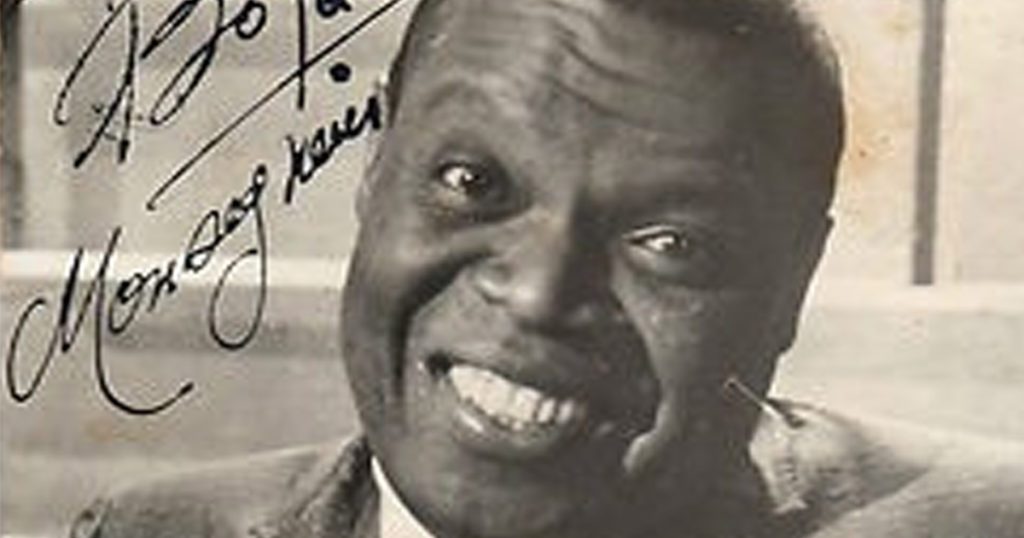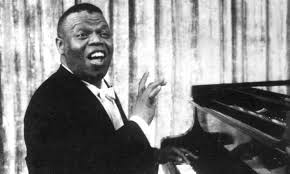BOLA DE NIEVE, CANTANTE Y COMPOSITOR, UN HOMBRE TRISTE QUE PASÓ SU VIDA ALEGRE. VÍDEOS
Bola de Nieve, nacido Ignacio Jacinto Villa Fernández, en Guanabacoa, Cuba el 11 de septiembre de 1911, fue un cantautor y pianista cubano. Villa Fernández estudió en el Conservatorio Mateu de La Habana.
Antes de convertirse en una figura musical de renombre, fue una de las figuras culturales más carismáticas de su época.
Su madre, Inés Fernández, era una consumada bailarina de rumba y su padre, Domingo Villa, cocinero. Ignacio asistió a una escuela primaria privada y comenzó su formación musical a los 12 años. Se graduó de la Escuela Normal para Maestros en 1927, aceptó un trabajo como pianista en el Cine Carral, una sala de cine mudo en Guanabacoa.
VIDEOS- BOLA DE NIEVE INTERPRETA….
Su primera gran oportunidad se produjo a principios de 1930. Mientras tocaba el piano en el Hotel Biltmore de Sevilla en La Habana, la cantante cubana Rita Montaner lo vio actuar y le pidió que tocara para ella.
Otra ruptura se produjo tres años después en México. Montaner (la cabeza de cartel) estaba enferma y no pudo actuar, y Villa la sustituyó. Cantó la afrocanción “Bito Manué”, adaptada del famoso poema de Nicolás Guillén y surgió una leyenda. Fue después de esta actuación que Montaner se refirió a él afectuosamente como “Bola de Nieve”, nombre que abrazó con humildad pero con orgullo.
Luego de que terminó la gira y Montaner regresó a Cuba, Bola permaneció en México, donde vivió la mayor parte de su vida. Pronto tuvo su primera actuación en solitario en el Teatro Politeama.
Era una figura de élite más que popular, un sofisticado estilista de cabaret conocido por su tono irónico y su sutil interpretación musical, con un repertorio que incluía canciones en francés, inglés, catalán, portugués e italiano.
Realizó numerosas giras por Europa y América, y entre sus amigos se encontraban Andrés Segovia y Pablo Neruda. Era negro y gay, confiaba en su personalidad y aceptaba lo que era: un talento memorable.
Bola fue comparado a menudo como cantante e intérprete con Louis Armstrong, su gemelo norteamericano. Compartían atributos físicos similares y muchas sensibilidades creativas y artísticas. Eran humildes, divertidos, encantadores y sofisticados. El estilo musical original de Bola a veces se compara con el chansonier francés.
Gracias a que sabía cantar en varios idiomas, incluidos español, catalán, francés, italiano, inglés y portugués, Bola compartió escenario con todos los grandes nombres musicales de su tiempo. Su producción creativa mostró las fuertes influencias africanas en la cultura cubana.
Su música universalizó la cultura musical cubana, tomando el mambo, la rumba y las canciones populares y creando su propia “Bola de Nieve”, que fue celebrada en Europa, Asia y Estados Unidos, así como en México, Argentina y América del Sur.
El 20 de agosto de 1971 Bola presidió un homenaje a Rita Montaner en el Teatro Amadeo Roldán. Menos de dos meses después, el 2 de octubre, Bola falleció en la Ciudad de México durante una visita musical de camino a Perú. Fue enterrado en Cuba.
De personalidad compleja, tanto en público como en privado, Bola era muy discreto acerca de su homosexualidad, pero no llegaba a negarla.
Fue objeto de un documental de 2003 que incluyó entrevistas con compañeros músicos, amigos, familiares y expertos.
ESTILO BOLA DE NIEVE
Fernández es una de las figuras más influyentes del jazz afrocubano. A menudo sintetizaba elementos de las tradiciones musicales europeas y norteamericanas con elementos latinos, lo que le daba a su música un sonido distinto al de sus contemporáneos.
Su música es a menudo profundamente emotiva, llegando incluso a sollozar abiertamente en sus letras.
FILMOGRAFÍA
Seleccionado
Melodías de América (1941)
BOLA DE NIEVE, (SNOWBALL), SINGER AND COMPOSER, A SAD MAN WHO SPENT HIS LIFE HAPPY. PHOTOS. VIDEOS
Bola de Nieve (literally Snowball), born Ignacio Jacinto Villa Fernández, in Guanabacoa, Cuba on September 11, 1911 was a Cuban singer-pianist and songwriter. Villa Fernández studied at the Mateu Conservatoire of Havana.
Before he became the renowned musical figure was one of the most charismatic cultural figure of his times.
His mother, Inez Fernandez, was an accomplished rumba dancer, and his father, Domingo Villa, a cook. Ignacio attended a private primary school, and began his musical training at the age of 12. He graduated from the Escuela Normal para Maestros in 1927, he took a job as a piano player at the Cinema Carral, a silent movie theatre in Guanabacoa.
His first major break came in early 1930. As he played the piano at the Biltmore Hotel Seville in Havana, Cuban singer Rita Montaner saw him perform and asked him to play for her.
Another break came three years later in Mexico. Montaner (the headliner) was sick and could not perform, and Villa substituted for her. He sang the afrocanción “Bito Manué,” adapted from the famous poem by Nicolás Guillén and a legend emerged. It was after this performance that Montaner referred to him affectionately as “Bola de Nieve,” a name he embraced humbly but proudly.
After the tour ended and Montaner returned to Cuba, Bola remained in Mexico, where he lived most of his life. He soon had his first solo performance at the Teatro Politeama.
He was an elite rather than a popular figure, a sophisticated cabaret stylist known for ironic patter, subtle musical interpretation, with a repertoire that included songs in French, English, Catalan, Portuguese, and Italian.
He toured widely in Europe and the Americas, and his friends included Andrés Segovia and Pablo Neruda. He was black and gay, and was self-confident in his personality, and accepted for what he was: a memorable talent.
Bola was often compared as a singer and performer to Louis Armstrong, his North American twin. They shared similar physical attributes, and many creative and artistic sensibilities. They were humble, humorous, charming and sophisticated. Bola’s original musical style is sometimes compared to French Chansonier.
Because he was able to sing in a number of languages, including Spanish, Catalan, French, Italian, English and Portuguese, Bola shared the stage with all the big musical names of his time. His creative output showcased the strong African influences on Cuban culture.
His music universalized Cuban musical culture, taking mambo, rumba and folk songs and making his own “Bola de Nieve” statement, which were celebrated in Europe, Asia and the U.S., as well as Mexico, Argentina and South America.
On August 20 1971, Bola presided over an homage to Rita Montaner at the Amadeo Roldan Theater. Less than two months later, on October 2, Bola died in Mexico City during a Musical visit in his way to Peru. He was buried in Cuba.
A complex personality, in public as much as in private, Bola was very discreet about his homosexuality, but not so far as denying it.
He was the subject of a 2003 documentary which included interviews with fellow musicians, friends, relatives, and experts.
BOLA DE NIEVE STYLE
Fernández is one of the most influential figures of Afro-Cuban jazz. He often synthesized elements of European and North American musical traditions with Latin elements, which gave his music a sound distinct from his contemporaries.
His music is often deeply emotional, going as far as to openly sob his lyrics.
FILMOGRAPHY
Selected
Melodies of America (1941)
Agencies/ Wiki/ BoladeNieveBio./ Extractos/ Excerpts/ Internet Photos/ YouTube/ Arnoldo Varona/ www.TheCubanHistory.com
THE CUBAN HISTORY, HOLLYWOOD.



 BOLA DE NIEVE, Cantante y Compositor, un hombre triste que pasó su vida Alegre. VIDEOS. * BOLA DE NIEVE, (Snowball), Singer and Composer, a Sad man who spent his Life Happy. PHOTOS. VIDEOS.
BOLA DE NIEVE, Cantante y Compositor, un hombre triste que pasó su vida Alegre. VIDEOS. * BOLA DE NIEVE, (Snowball), Singer and Composer, a Sad man who spent his Life Happy. PHOTOS. VIDEOS.





